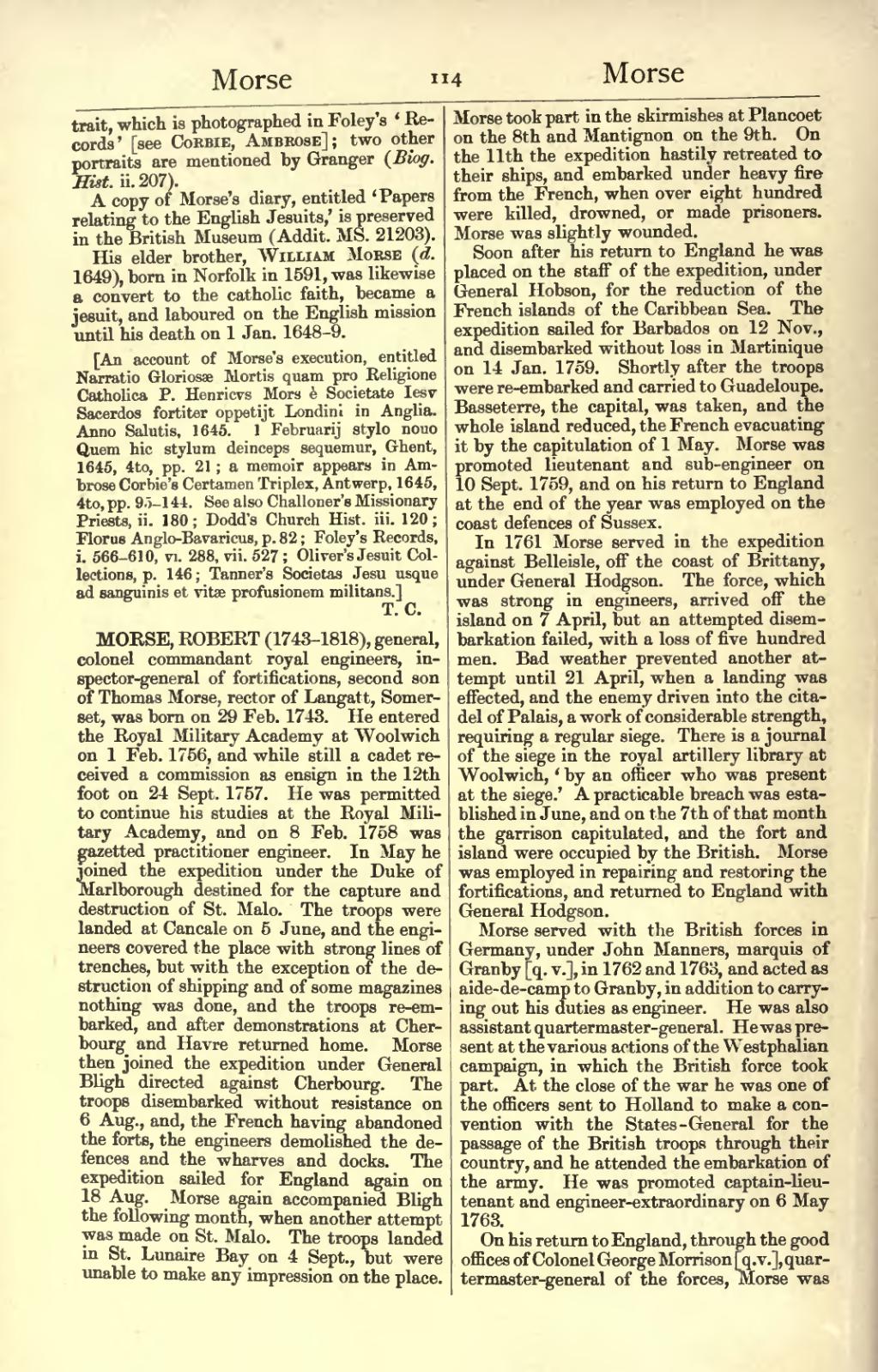trait, which is photographed in Foley's 'Records' [see Corbie, Ambrose]; two other portraits are mentioned by Granger (Biog. Hist. ii.207).
A copy of Morse's diary, entitled 'Papers relating to the English Jesuits,' is preserved in the British Museum (Addit. MS. 21203).
His elder brother, William Morse (d. 1649), born in Norfolk in 1591, was likewise a convert to the catholic faith, became a Jesuit, and laboured on the English mission until his death on 1 Jan. 1648-9.
[An account of Morse's execution, entitled Narratio Gloriosæ Mortis quam pro Religione Catholica P. Henricvs Mors è Societate Iesv Sacerdos fortiter oppetijt Londini in Anglia. Anno Salutis, 1645. 1 Februarij stylo nouo Quem hic stylum deinceps sequemur, Ghent, 1645, 4to, pp. 21; a memoir appears in Ambrose Corbie's Certamen Triplex, Antwerp, 1645, 4to, pp. 95–144. See also Challoner's Missionary Priests, ii. 180; Dodd's Church Hist. iii. 120; Florus Anglo-Bavaricus, p. 82; Foley's Records, i. 566–610, vi. 288, vii. 527; Oliver's Jesuit Collections, p. 146; Tanner's Societas Jesu usque ad sanguinis et vitæ profusionem militans.]
MORSE, ROBERT (1743–1818), general, colonel commandant royal engineers, inspector-general of fortifications, second son of Thomas Morse, rector of Langatt, Somerset, was born on 29 Feb. 1743. He entered the Royal Military Academy at Woolwich on 1 Feb. 1756, and while still a cadet received a commission as ensign in the 12th foot on 24 Sept. 1757. He was permitted to continue his studies at the Royal Military Academy, and on 8 Feb. 1758 was gazetted practitioner engineer. In May he joined the expedition under the Duke of Marlborough destined for the capture and destruction of St. Malo. The troops were landed at Cancale on 5 June, and the engineers covered the place with strong lines of trenches, but with the exception of the destruction of shipping and of some magazines nothing was done, and the troops re-embarked, and after demonstrations at Cherbourg and Havre returned home. Morse then joined the expedition under General Bligh directed against Cherbourg. The troops disembarked without resistance on 6 Aug., and, the French having abandoned the forts, the engineers demolished the defences and the wharves and docks. The expedition sailed for England again on 18 Aug. Morse again accompanied Bligh the following month, when another attempt was made on St. Malo. The troops landed in St. Lunaire Bay on 4 Sept., but were unable to make any impression on the place. Morse took part in the skirmishes at Plancoet on the 8th and Mantignon on the 9th. On the llth the expedition hastily retreated to their ships, and embarked under heavy fire from the French, when over eight hundred were killed, drowned, or made prisoners. Morse was slightly wounded.
Soon after his return to England he was placed on the staff of the expedition, under General Hobson, for the reduction of the French islands of the Caribbean Sea. The expedition sailed for Barbados on 12 Nov., and disembarked without loss in Martinique on 14 Jan. 1759. Shortly after the troops were re-embarked and carried to Guadeloupe. Basseterre, the capital, was taken, and the whole island reduced, the French evacuating it by the capitulation of 1 May. Morse was promoted lieutenant and sub-engineer on 10 Sept. 1759, and on his return to England at the end of the year was employed on the coast defences of Sussex.
In 1761 Morse served in the expedition against Belleisle, off the coast of Brittany, under General Hodgson. The force, which was strong in engineers, arrived off the island on 7 April, but an attempted disembarkation failed, with a loss of five hundred men. Bad weather prevented another attempt until 21 April, when a landing was effected, and the enemy driven into the citadel of Palais, a work of considerable strength, requiring a regular siege. There is a journal of the siege in the royal artillery library at Woolwich, 'by an officer who was present at the siege.' A practicable breach was established in June, and on the 7th of that month the garrison capitulated, and the fort and island were occupied by the British. Morse was employed in repairing and restoring the fortifications, and returned to England with General Hodgson.
Morse served with the British forces in Germany, under John Manners, marquis of Granby [q. v.], in 1762 and 1763, and acted as aide-de-camp to Granby, in addition to carrying out his duties as engineer. He was also assistant quartermaster-general. He was present at the various actions of the Westphalian campaign, in which the British force took part. At the close of the war he was one of the officers sent to Holland to make a convention with the States-General for the passage of the British troops through their country, and he attended the embarkation of the army. He was promoted captain-lieutenant and engineer-extraordinary on 6 May 1763.
On his return to England, through the good offices of Colonel George Morrison [q.v.], quartermaster-general of the forces, Morse was
